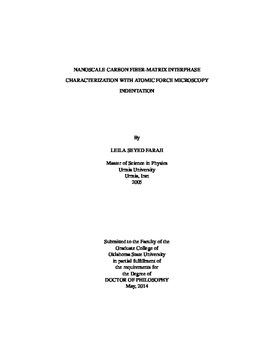| dc.contributor.advisor | Singh, Raman P. | |
| dc.contributor.author | Seyed Faraji, Leila | |
| dc.date.accessioned | 2015-06-17T20:07:58Z | |
| dc.date.available | 2015-06-17T20:07:58Z | |
| dc.date.issued | 2014-05 | |
| dc.identifier.uri | https://hdl.handle.net/11244/15115 | |
| dc.description.abstract | At the region between fiber and matrix in a composite there is a region called interphase region, which basically has different properties than bulk matrix and fiber. This region is responsible for the loads transfer from the matrix to the fibers. Size of the interphase region is very small and it is expected to vary from 100nm to less than 1μ m. Direct measurement of mechanical properties of the interphase region is challenging and requires development of novel techniques. To characterize mechanical behavior of local surface, nanoindentation with atomic force microscopy (AFM) was implemented. Using MFP3D AFM, a test setup was developed to characterize the region with variable contact areas and contact forces. A series of radial line scan nanoindentations, starting from the center of cross-sectioned fiber ending in matrix far away enough from interface, was used for characterization. Measurement of quantitative mechanical properties using an AFM indentation requires several things to be considered. For example AFM tip geometry is not simple like Berkovich indenter. AFM tip is small enough to get response from the change in properties in narrow interphase region. Important observation includes the range in measured elastic modulus at matrix side, gradually increasing at interface of fiber-matrix. The remarkable elastic modulus increment proves the AFM tip contacted harder material at interphase region. Such a measurement provides reliable knowledge of interphase properties. Several measurement were conducted to achieve consist and reliable data. The measurement validated with Berkovich indentation method. Sample preparation for such a measurement was found to be a critical issue. A method of cutting samples with ultramicrotome found to be the best method. AFM indentation at interphase of carbon fiber matrix was performed with different indentation depth or loads. Results of AFM indentation helped us to proof the presence of interphase. The interphase of carbon fiber epoxy matrix was measured around 200nm with this method. Elastic modulus of polymer gradually increases at interphase region from 3.0GPa up to 10GPa. Increment of elastic modulus in interphase is attributed to radial alignment of polymer chains. When polymer chains are aligned in a plane it is hard for the indenter to penetrate through the polymer. Elastic modulus measurements with 10, 15 and 30 nm penetration depth, was found to be reasonably similar and independent of penetration depth. We experimentally validated our hypothesis that the ratio of dm/d, that constraint effect is ignorable while interpreting the nanoindentation data at fiber--polymer interphase, is determinable with a series of indentation with different maximum depth dm/d at constant distance d from fiber interface. We found that interpretation of nano indentation data at interphase with homogeneous model is valid and not affected by constraint effect, if maximum depth is less than one fourth of distance from the fiber. | |
| dc.format | application/pdf | |
| dc.language | en_US | |
| dc.rights | Copyright is held by the author who has granted the Oklahoma State University Library the non-exclusive right to share this material in its institutional repository. Contact Digital Library Services at lib-dls@okstate.edu or 405-744-9161 for the permission policy on the use, reproduction or distribution of this material. | |
| dc.title | Nanoscale carbon fiber-matrix interphase characterization with atomic force microscopy indentation | |
| dc.contributor.committeeMember | Vaidyanathan, Ranji | |
| dc.contributor.committeeMember | Kalkan, A. Kaan | |
| dc.contributor.committeeMember | Harimkar, Sandip P. | |
| osu.filename | SeyedFaraji_okstate_0664D_13193.pdf | |
| osu.accesstype | Open Access | |
| dc.type.genre | Dissertation | |
| dc.type.material | Text | |
| thesis.degree.discipline | Mechanical Engineering | |
| thesis.degree.grantor | Oklahoma State University | |
